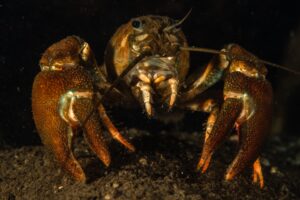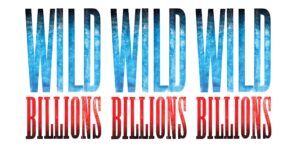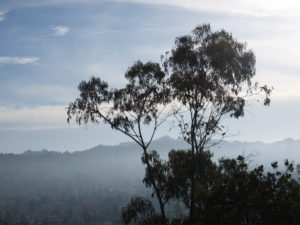In our October-December 2004 issue, Bay Nature reported on efforts to restore once-thriving Bay populations of the West Coast oyster, Ostrea conchaphila, which were devastated by a complex mix of Gold Rush-era sedimentation, Bay fill, pollution, and over-harvesting. In the last few years, several pilot restoration projects—many funded by the National Oceanic and Atmospheric Administration (NOAA) Restoration Center—have proven that artificial reefs made of wooden palettes and cleaned exotic oyster shells can provide the hard surfaces that the native oysters need to survive.
In Richardson Bay, fisheries biologist Michael McGowan and Tiburon Audubon Center recently set out a second round of artificial reefs. At the Marin Rod and Gun Club by the western foot of the Richmond-San Rafael Bridge, Robert Abbott of Strategic Environmental and members of the club have installed reef palettes, 40 stakes with oyster shells, and 30 oyster necklaces. Farther south, in Redwood City, NOAA’s Brian Mulvey installed artificial reef palettes close to the mouth of Redwood Creek near Bair Island. Researchers are investigating rates of recruitment, survival, and reproduction, as well as the synergistic effects of eelgrass and oysters working side by side.
“These pilot projects are important to begin restoration efforts and to provide interest, enthusiasm, and knowledge to the scientific community and the public, but it’s also important to look at the bigger picture,” says Coastal Conservancy Project Manager Abe Doherty.
Last June, Doherty recommended that the new California Ocean Protection Council authorize the Coastal Conservancy to provide $150,000 for a regional San Francisco Bay Oyster Restoration Plan. Because San Francisco Bay has been so seriously plagued by invasive species, pollution, and sediment problems, it is difficult to know whether any large-scale project could succeed in reestablishing sizable sustainable oyster populations, says Doherty. The Bay-wide project will collect new information on oyster diseases and predators and identify where oysters are currently distributed around the Bay. Working with NOAA, the Coastal Conservancy will also hold public workshops about the current restoration work. For workshop details, contact Abe Doherty at adoherty@scc.ca.gov. To find out about volunteering or even starting your own restoration project, call Natalie Cosentino-Manning of NOAA at (707)575-6081.
When native oysters flourished in the Bay, the large reefs they formed provided complex habitat for many other native species. Today, the oysters and other natives face not just habitat destruction but also an ever-increasing number of invasive species, including the likes of the Atlantic oyster drill, a tiny snail-with-an-attitude that bores a hole through an oyster’s shell with its ragged tongue, feeding on the animal’s soft tissue. Andrew Cohen, director of San Francisco Estuary Institute’s Biological Invasions Program, says San Francisco Bay may be the “world’s most invaded estuary, with over 250 exotic species established within the reach of its tides.”
Aiming to assist with oyster restoration efforts, Cohen and the San Francisco Estuary Institute launched a new website to provide information on the Bay’s most prevalent exotic species. Created with start-up funding from NOAA, the Guide to the Exotic Species of San Francisco Bay, found at www.exoticsguide.org, supplies images and accessible information about exotic species in the San Francisco Bay.
“Both in terms of common San Francisco Bay species and frequently encountered exotic species on the Pacific Coast, there’s no other website or illustrated resource that provides this sort of coverage or information,” says Cohen.

.jpg)



